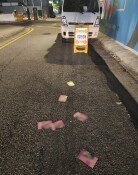Pyongyang capable of artillery shells firing pose serious threat to Seoul
Pyongyang capable of artillery shells firing pose serious threat to Seoul
Posted October. 13, 2023 08:34,
Updated October. 13, 2023 08:34

It has been reported that the South Korean version of “Iron Dome,” a low altitude missile defense (LAMD) system which the military has been developing, will turn out to be severely susceptible to North Korean artillery shells even if it will have been completed by 2026. The system can only intercept 2,000 rockets whereas Pyongyang is capable of firing more than 10,000 shells per hour. Added to this, it provides protection to only a dozen facilities in the capital area, leaving the rest of the nation defenseless. Since the “Iron Dome,” Israel’s perceived cutting-edge intercept and defense system, ended up helpless against the reckless bombardment of rockets carried out by Palestinian armed group Hamas, experts have pointed out that Seoul should come up with complementary defense measures to take against North Korean threats.
“I have been told that relevant agencies are double-checking the country’s capabilities of responding to North Korean intelligence activities and provocations following the conflict between Hamas and Israel,” a South Korean top government official said in a telephone interview with The Dong-A Ilbo on Thursday. “The government is looking seriously into its defense capacity to protect against a possible barrage of North Korean artillery attacks, which are considered way more threatening than the weapons in the hands of Hamas.
In particular, North Korean long-range artillery shells are assessed as the most destructive weapon according to the South Korean government and military authorities. At the North Korean frontlines are 700 artillery shells aiming at the South, including 170mm self-propelled artillery guns and 240mm multiple rocket launchers. According to the South Korean government, around 300 shells or so are presumed to target the Seoul metropolitan area.
In a scenario where up to 10,000 long-range artillery shells fly at a low altitude of 10 kilometers in an hour, the existing intercept system on the South end will not keep the country completely safe. With this in mind, Seoul has developed a LAMD system costing a budget of 2.8 trillion won. However, the system is unlikely to block an all-out bombing successfully as it is only capable of intercepting up to 2,000 rockets. Although the timeline for the completion of the LAMD project was brought forward from 2029 to 2026 as part of the Yoon Suk Yeol administration's efforts to fortify the “Three-Axis'' system including the Korea Air and Missile Defense system, there are still concerns about whether they can respond effectively. As part of the solution to insufficient defense capabilities, experts argue that Seoul should upgrade the planned LAMD system in terms of intercept capabilities or introduce another defense system. Military advisers agree that South Korea needs to strike the origin of provocation as fast as possible once the North's first airstrike is carried out by getting an additional quantity of tactical surface-to-surface missiles and other ballistic missiles ready.
“How Hamas has invaded Israel has implications in that a similar war scenario may unfold if Pyongyang starts war,” Chairman of the Joint Chiefs of Staff (JCS) Kim Seung-gyeom said in a parliamentary inspection led by the National Defense Committee on Thursday. He assessed that Hamas used various deceptive tactics to successfully carry out a sudden attack. Asked by People’s Power Party lawmaker Sung Il-jong if Hamas can be compared to North Korea regarding military capabilities, Kim firmly replied that it lags way behind the latter.
Kyu-Jin Shin newjin@donga.com







